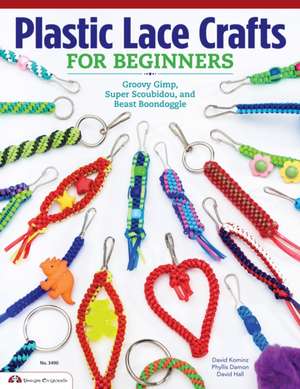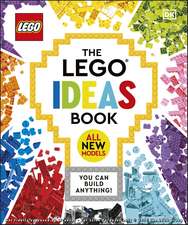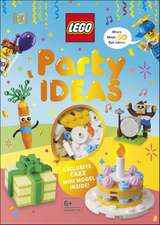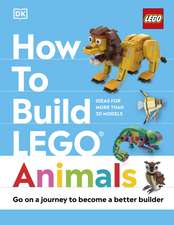Plastic Lace Crafts for Beginners: Groovy Gimp, Super Scoubidou, and Beast Boondoggle
Autor Phyllis Damon, David Kominz, David Hallen Limba Engleză Paperback – 31 aug 2013
Whether you call it gimp, lanyard, scoubidou, or boondoggle, vinyl craft lace is the perfect activity for home, camp, school or party. And Plastic Lace Crafts for Beginners is the perfect way to get started in this easy-to-learn craft. This book shows readers all of the essential stitches and skills they need to master the art of plastic lacing, with easy-to-follow weaving diagrams and colorful photos of finished projects. 17 simple but fun projects are provided for making cool zipper pulls, key chains, bracelets, decorations and more. Every braid is clearly illustrated, so instructions are a cinch to follow. The projects include imaginative columns, fishtails, ankhs, hearts, and free flow designs, and use fun accents like beads and pom poms. The authors begin by teaching the fundamental 4-strand technique, then move on to more complicated 6-strand designs.
Preț: 37.73 lei
Nou
Puncte Express: 57
Preț estimativ în valută:
7.22€ • 7.54$ • 5.98£
7.22€ • 7.54$ • 5.98£
Carte disponibilă
Livrare economică 14-28 martie
Livrare express 27 februarie-05 martie pentru 14.09 lei
Preluare comenzi: 021 569.72.76
Specificații
ISBN-13: 9781574213676
ISBN-10: 1574213679
Pagini: 16
Ilustrații: color photos throughout
Dimensiuni: 182 x 276 x 6 mm
Greutate: 0.1 kg
Editura: Design Originals
ISBN-10: 1574213679
Pagini: 16
Ilustrații: color photos throughout
Dimensiuni: 182 x 276 x 6 mm
Greutate: 0.1 kg
Editura: Design Originals
Notă biografică
Phyllis Damon began her career teaching weaving and supplying craft materials in educational settings. David Kominz, a retired NIH medical researcher, joined forces with Phyllis in the creation and publication of craft books. Together with master designer of plastic lacing, David Hall, they turned out three plastic lacing books. Their goal has been to help kids have fun and develop creativity through basic craft skills.
Textul de pe ultima copertă
Whether you call it gimp, lanyard, scoubidou, or boondoggle, you can weave and knot vinyl craft lace to create lots of nifty toys and trinkets-once you know how! Plastic Lace Crafts for Beginners is the perfect way to get started in this easy-to-learn craft. This book will teach you all of the essential stitches and skills you need to master the colorful art of plastic lacing. 17 simple but fun projects are provided for making cool zipper pulls, key chains, bracelets, decorations and more. Every braid is clearly illustrated, so instructions are a cinch to follow. You'll discover how to weave imaginative columns, fishtails, ankhs, hearts, and free flow designs, and use fun accents like beads and pom-poms. Begin by learning the fundamental 4-strand technique, then move on to the 6-strand technique and more complicated designs. Soon you'll be hunting for more projects, or making up your own as a craft-lacing expert. Time to get knotting! Inside you'll find: ? 17 fun projects for zipper pulls, key chains and bracelets ? Essential skills for stitching, braiding and knotting ? Both 4-strand and 6-strand techniques ? Imaginative designs for columns, fishtails, ankhs, hearts & more ? Easy-to-follow weaving diagrams and colorful photos of finished projects
Descriere
Whether you call it gimp, lanyard, scoubidou, or boondoggle, vinyl craft lace is the perfect activity for home, camp, school or party. And Plastic Lace Crafts for Beginners is the perfect way to get started in this easy-to-learn craft. This book shows readers all of the essential stitches and skills they need to master the art of plastic lacing, with easy-to-follow weaving diagrams and colorful photos of finished projects. 17 simple but fun projects are provided for making cool zipper pulls, key chains, bracelets, decorations and more. Every braid is clearly illustrated, so instructions are a cinch to follow. The projects include imaginative columns, fishtails, ankhs, hearts, and free flow designs, and use fun accents like beads and pom poms. The authors begin by teaching the fundamental 4-strand technique, then move on to more complicated 6-strand designs.





















